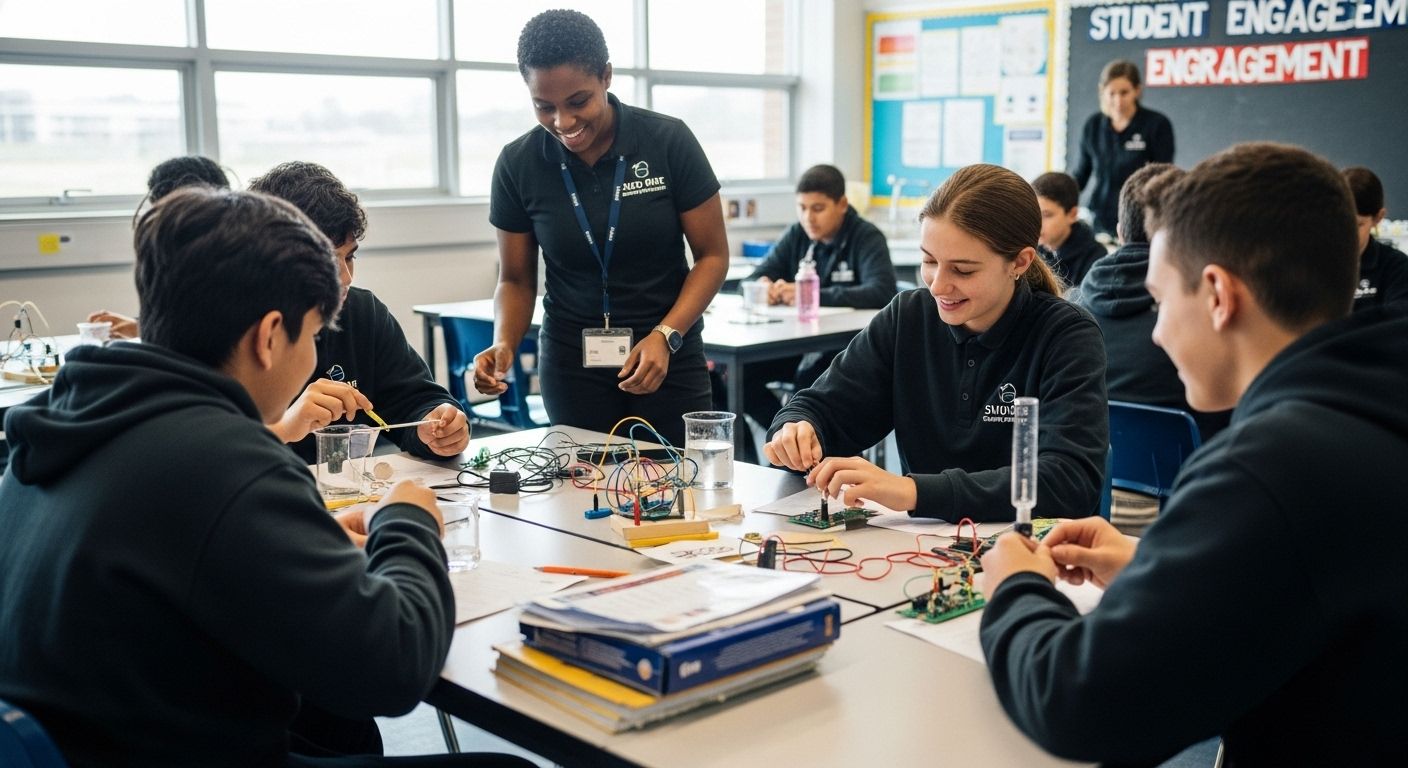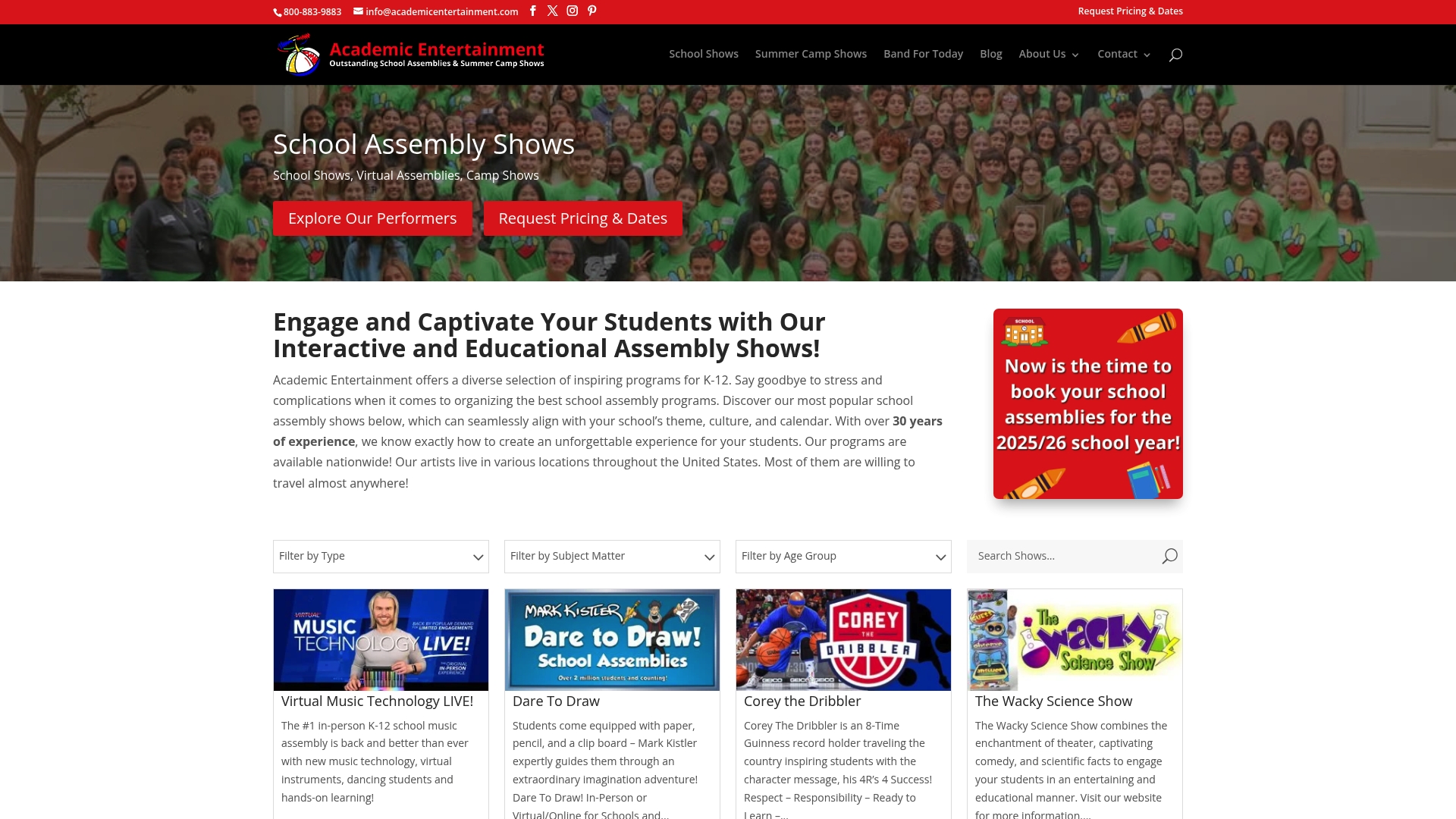Schools across the country are rethinking assemblies and shifting toward interactive models that get every student involved. Programs with intentional participation see up to 30 percent higher reported student engagement according to research from the National Association of School Principals. That sounds impressive, but most people imagine assemblies as kids simply sitting and watching from the bleachers. What surprises many is that these new interactive assemblies make the audience the main event, transforming a passive crowd into an active force for learning.
Table of Contents
- Defining Interactive Assemblies: Key Features And Characteristics
- The Importance Of Interactive Assemblies In Education
- How Interactive Assemblies Foster Engagement And Learning
- Best Practices For Implementing Interactive Assemblies
- Real-World Examples Of Successful Interactive Assemblies
Quick Summary
| Takeaway | Explanation |
|---|---|
| Interactive assemblies engage students actively | These events prioritize participation, encouraging students to contribute, discuss, and collaborate during their learning experiences. |
| Holistic development is a key focus | Beyond academics, interactive assemblies help build communication skills, emotional intelligence, and cultural awareness among students. |
| Effective planning enhances success | Careful design and clear learning goals are crucial for creating impactful interactive assemblies that maximize engagement. |
| Engagement strategies foster better retention | Utilizing multimedia and real-time problem-solving activities helps activate multiple learning pathways, improving student understanding. |
| Real-world applications deepen learning | Interactive assemblies, like civic education models, allow students to practice critical thinking and collaborative skills in real-life contexts. |
Defining Interactive Assemblies: Key Features and Characteristics
Interactive assemblies represent a dynamic educational approach that transforms traditional school gatherings into engaging, participatory experiences. Unlike conventional assemblies where students passively listen, these modern events actively involve participants through direct interaction, collaboration, and experiential learning.
Core Components of Interactive Assemblies
At their essence, interactive assemblies are structured educational events designed to foster student engagement, critical thinking, and meaningful connection. According to research from the National Association of School Principals, these programs prioritize student involvement over one-way communication.
Key characteristics include:

- Intentional audience participation
- Multimedia and multi-sensory learning experiences
- Real-time feedback and interaction mechanisms
- Goals focused on skill development and knowledge acquisition
Transformative Learning Dynamics
Interactive assemblies break traditional learning barriers by creating immersive environments where students become active contributors rather than passive recipients. They leverage techniques like live demonstrations, group problem solving, collaborative discussions, and hands-on activities to create memorable educational moments.
For schools seeking innovative ways to enhance student experiences, virtual school assembly ideas offer additional insights into modern engagement strategies. These events can seamlessly blend entertainment with educational objectives, making learning both enjoyable and impactful.
Through strategic design and thoughtful implementation, interactive assemblies represent a powerful tool for modern educators committed to creating dynamic, student-centered learning environments.
To help distinguish interactive assemblies from traditional ones, the table below compares their core features and educational impacts.
| Aspect | Traditional Assemblies | Interactive Assemblies |
|---|---|---|
| Student Role | Passive listener | Active participant |
| Primary Method | One-way presentation | Collaborative, two-way interaction |
| Engagement Level | Low to moderate | High, up to 30% higher engagement |
| Activities | Speeches, performances | Live demonstrations, group problem solving, discussions |
| Learning Focus | Information delivery | Skill development, experiential learning |
| Feedback Mechanisms | Minimal or none | Real-time feedback, direct involvement |
| Retention | Often low | Higher due to participation and multisensory input |
The Importance of Interactive Assemblies in Education
Interactive assemblies have emerged as a critical educational strategy that goes beyond traditional information sharing, transforming school gatherings into powerful learning experiences. These innovative approaches are not merely events but strategic opportunities to enhance student engagement, foster holistic development, and create meaningful educational connections.
Advancing Holistic Student Development
Beyond academic learning, interactive assemblies play a crucial role in students’ comprehensive growth. Understanding the core objectives of school assemblies reveals their multifaceted impact on student development. These events serve as platforms for:
- Developing critical communication skills
- Encouraging collaborative problem solving
- Building social and emotional intelligence
- Promoting cultural awareness and understanding
According to research from the National Education Association, interactive assemblies provide unique opportunities for students to learn beyond traditional classroom boundaries, creating immersive experiences that stimulate intellectual curiosity and personal growth.
Pedagogical and Psychological Benefits
Interactive assemblies represent more than entertainment they are strategic educational interventions. By designing experiences that require active participation, schools can create environments that support different learning styles, enhance student motivation, and develop essential life skills. These assemblies challenge students to think critically, express themselves confidently, and engage with complex ideas in dynamic, supportive settings.
The psychological impact is equally significant. When students feel genuinely involved and see their contributions valued, they develop stronger connections to their learning community, increased self esteem, and a more positive attitude toward education. This approach transforms assemblies from passive listening experiences into transformative educational moments that resonate far beyond the event itself.
The following table outlines the main benefits of interactive assemblies for student development, as elaborated in the article.
| Area of Development | Benefit Provided | How Assemblies Support It |
|---|---|---|
| Communication Skills | Improved expression and active listening | Collaborative discussions and presentations |
| Social & Emotional Intelligence | Increased empathy and self-esteem | Group activities and audience participation |
| Critical Thinking | Enhanced problem-solving abilities | Real-time challenges and inquiry-based learning |
| Cultural Awareness | Broadened understanding of diversity | Exposure to multicultural topics and viewpoints |
| Motivation & Engagement | Greater enthusiasm for learning | Immersive, participatory experiences |
| Knowledge Retention | Higher long-term recall | Interactive, multi-sensory methods |
How Interactive Assemblies Foster Engagement and Learning
Interactive assemblies represent a transformative approach to educational experiences, moving beyond traditional passive learning models to create dynamic, participatory environments that actively capture student attention and stimulate intellectual curiosity. These innovative gatherings are strategically designed to enhance student engagement through multiple interactive mechanisms.
Mechanisms of Student Engagement
At the core of interactive assemblies are sophisticated engagement strategies that transform learning from a one-way transmission of information into a collaborative, multisensory experience. Exploring science assembly programs reveals how these events can make complex concepts accessible and exciting for students.
Key engagement mechanisms include:
- Immediate audience participation
- Real-time problem solving challenges
- Interactive demonstration techniques
- Multimedia storytelling approaches
- Personalized learning experiences
According to research from Yale University, these engagement strategies activate multiple cognitive pathways, ensuring that students are not just passive observers but active participants in their learning journey.
Psychological and Cognitive Benefits
Interactive assemblies leverage fundamental principles of cognitive psychology to create powerful learning environments. By designing experiences that require active mental and often physical participation, these events stimulate different learning styles and cognitive processing methods. Students become co-creators of knowledge rather than mere recipients, which significantly enhances information retention and conceptual understanding.
The psychological impact is profound. When students feel genuinely involved and see their contributions valued, they develop increased motivation, self confidence, and a more positive relationship with learning. Interactive assemblies break down traditional educational barriers, creating inclusive spaces where every student can feel seen, heard, and intellectually challenged.
Best Practices for Implementing Interactive Assemblies
Successful interactive assemblies require strategic planning, thoughtful design, and a nuanced understanding of student engagement principles. These events are not spontaneous gatherings but carefully crafted experiences that demand intentional preparation and execution to maximize their educational potential.
Strategic Planning and Design
Effective interactive assemblies begin with comprehensive planning that considers the specific learning objectives, audience demographics, and desired outcomes. Exploring virtual school assembly strategies reveals the importance of adaptable, technology-enhanced approaches that can accommodate diverse learning environments.
Critical planning considerations include:
- Clear articulation of learning goals
- Age appropriate content selection
- Balanced mix of instructional and interactive elements
- Incorporation of multiple sensory learning modalities
- Mechanisms for real time student feedback
According to research from Edutopia, successful interactive assemblies create environments that encourage active participation while maintaining structured learning frameworks.
Facilitating Meaningful Engagement
The success of interactive assemblies hinges on creating an inclusive, supportive atmosphere where students feel empowered to contribute. Facilitators must develop skills in dynamic presentation, adaptive communication, and responsive audience management. This involves reading the room, adjusting content delivery in real time, and creating safe spaces for student expression.
Key engagement techniques include using provocative questions, encouraging collaborative problem solving, integrating multimedia resources, and providing opportunities for students to share personal perspectives. By transforming assemblies from lecture style presentations to collaborative learning experiences, schools can create powerful educational moments that resonate beyond the event itself.
Real-World Examples of Successful Interactive Assemblies
Interactive assemblies have proven to be powerful educational tools across diverse learning environments, transforming traditional information delivery into dynamic, participatory experiences that engage students on multiple levels. These real-world examples demonstrate the profound potential of thoughtfully designed interactive gatherings.
Civic Education and Engagement Models
Exploring assembly program benefits reveals the transformative power of interactive experiences in educational settings. Civic education assemblies provide compelling illustrations of how interactive approaches can make complex subjects accessible and engaging.
Notable interactive assembly models include:
- Model United Nations simulations
- Constitutional law role playing workshops
- Student government leadership conferences
- Historical reenactment experiences
- Civic engagement challenge programs
According to research from the California Department of Education, these interactive assemblies enable students to develop critical thinking skills, understand complex social systems, and practice collaborative problem solving in real world contexts.
STEM and Experiential Learning Demonstrations
Science and technology interactive assemblies represent another powerful approach to engaging students through hands on, immersive experiences. These gatherings transform abstract scientific concepts into tangible, memorable learning moments. By incorporating live demonstrations, audience participation, and interactive technology, schools can create assembly experiences that spark curiosity and inspire deeper scientific understanding.
Interactive STEM assemblies break down traditional barriers between learners and complex subjects, creating environments where students become active participants in scientific exploration. Whether through robotics demonstrations, climate change simulations, or collaborative engineering challenges, these assemblies prove that learning can be both intellectually rigorous and genuinely exciting.

Bring Your Interactive Assembly Vision to Life
Are you struggling to turn passive assemblies into meaningful and memorable learning experiences? The article above highlights just how essential interactive assemblies are for boosting student engagement, encouraging active participation, and fostering real-life skills. You want assemblies that not only capture attention but also motivate students and create lasting impact. With evolving student needs and pressure to make every event count, a one-size-fits-all approach no longer works.

Discover how Academic Entertainment can help you transform your next event into an immersive, student-centered experience. With over 40 years of expertise, we offer a wide range of live and virtual interactive assemblies tailor-made for your school’s unique objectives. Whether you are interested in science assemblies that spark excitement or want guidance on virtual interactive programs, our customizable solutions make it easy. Act now to create an event your students will remember. Visit our main site and start planning your unforgettable assembly experience today.
Frequently Asked Questions
What is the purpose of interactive assemblies?
Interactive assemblies aim to transform traditional school gatherings into engaging and participatory experiences that foster student involvement and critical thinking.
How do interactive assemblies enhance student engagement?
These assemblies use mechanisms such as live demonstrations, real-time participation, and collaborative problem-solving tasks to actively engage students and make learning more dynamic.
What benefits do interactive assemblies provide for student development?
Interactive assemblies contribute to the development of critical communication skills, social and emotional intelligence, and cultural awareness through hands-on, interactive experiences.
What are effective strategies for implementing interactive assemblies?
Successful implementation involves strategic planning, clear learning objectives, age-appropriate content, and techniques that encourage meaningful engagement and student expression.




